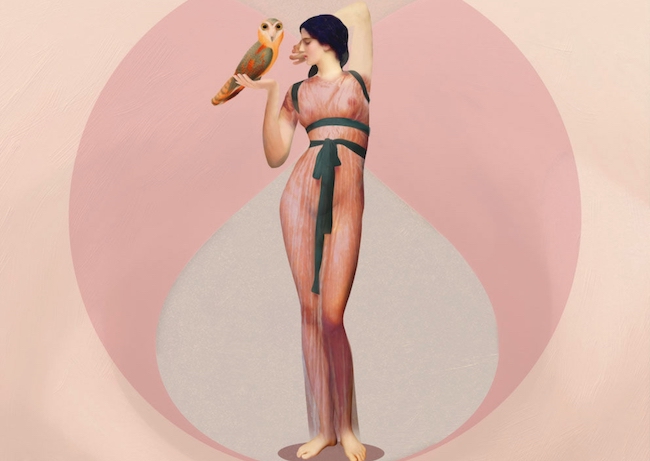La donna, come simbolo di armonia e bellezza, ha sempre costituito un fascino irresistibile per un mondo artistico prevalentemente appannaggio degli uomini, almeno fino a prima degli ultimi due secoli; dunque l’impulso era quello di immortalarne l’estetica mescolandola a un’aura celestiale, in particolar modo quando veniva raffigurata sotto forma di divinità, oppure di scoprirne il mistero celato dietro sguardi, espressioni, pose. Eppure malgrado la maestria dei grandi nomi della pittura internazionale, la vera essenza della femminilità sembrava sfuggire proprio a causa di quei silenzi, di quei pensieri nascosti che appartenevano alle buone maniere e al modo di vivere di tanto tempo fa. L’artista di cui vi racconterò oggi racconta, con il suo personale stile, il percorso effettuato da iconiche figure femminili che hanno aperto la strada all’affrancamento dal ruolo tradizionale per entrare finalmente nella storia, ciascuna nel suo personale raggio d’azione; dopo di cui niente è stato più come prima.
Nel corso della storia dell’arte non è esistita figura più ammirata, celebrata e ritratta della donna con tutte le sue sfaccettature e le modificazioni estetiche che si sono avvicendate nel tempo sulla base dei gusti, delle regole sociali ed estetiche di ciascun periodo; dunque attraverso le opere di Leonardo da Vinci, di Botticelli, di Tiziano, di Vermeer, e poi ancora con Giovanni Boldini, Edgar Degas, Claude Monet, si ha una traccia dei canoni di bellezza, di abbigliamento e di quella grazia innata che questi mostri sacri della pittura hanno saputo mettere in evidenza. Con il periodo moderno e l’avvicinarsi del Novecento l’approccio all’arte cominciò a cambiare così come il modo di vivere e di pensare che sfociò nelle grandi proteste e rivoluzioni sociali, dunque cominciarono a emergere anche i talenti artistici e professionali di quelle che potrebbero essere definite le pioniere dei successivi e più incisivi movimenti di emancipazione volti alla conquista di diritti e possibilità che prima non esistevano; l’arte fu promotrice in tal senso, poiché la pittura era un campo considerato possibile per la donna, malgrado fino a quel momento solo Artemisia Gentileschi, Fede Galizia e poche altre avevano osato affermarsi in un mondo prettamente al maschile. Pertanto nell’Impressionismo la strada per Mary Cassat e Berthe Morisot era già stata aperta dalle coraggiose e ardite pittrici dei secoli precedenti, anche se il percorso per veder riconosciuta la possibilità di raggiungere la fama dei colleghi uomini era ancora lungo. Fu il Novecento e l’audacia di donne determinate, volitive e anticonformiste come Frida Kahlo, Tamara de Lempicka, Paula Rego, Niki de Sain Phalle, Joan Mitchell, a segnare l’inizio del consolidamento dell’arte al femminile dando dunque un punto di vista differente, più empatico e rivelatore della vera essenza che non riusciva a essere davvero mai scoperta dall’interpretazione, seppur a volte infinitamente poetica, data dai maestri uomini del passato. Ma il Novecento costituì una rivoluzione sotto molti punti di vista pertanto alcune donne, le più audaci e temerarie, ebbero la possibilità di farsi valere anche in altri campi, dalle scienze alla letteratura passando per l’emergente mondo della moda. Ed è proprio in questa congiunzione di grandi menti, di percorsi difficili, ostacolati ma combattuti fino a raggiungere la realizzazione del sogno professionale divenendo persino ispirazione per le generazioni successive, che si concretizza l’ultima produzione artistica di Piero Campanini dal titolo Veneri Millenarie, un vero e proprio focus sulle personalità femminili del passato che hanno saputo scrivere una storia diversa in grado di squarciare e rompere i limiti e gli schemi della società in cui hanno vissuto, e divenendo un iconico esempio da seguire per intere generazioni di donne.
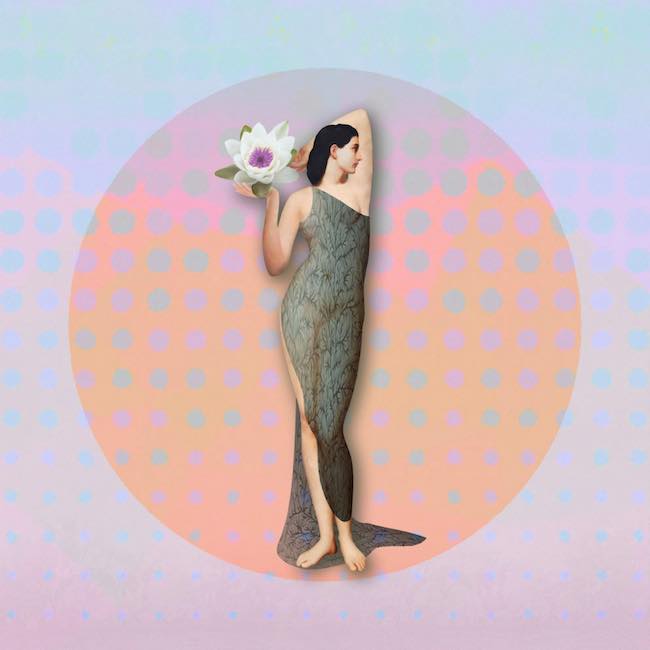
Non è un approccio contemplativo quello dell’artista, piuttosto è uno sguardo che parte dall’estetica per andare a fondo verso la sostanza, verso il significato più rilevante che la loro storia ha messo in luce, quello cioè che in fondo tutto è possibile, sempre e da sempre, malgrado troppo spesso la donna non abbia creduto, e forse ancora non creda, in se stessa; queste vere e proprie eroine invece hanno saputo dimostrare quanto i limiti appartengano solo alle convinzioni restrittive della società e dell’ambiente esterno a cui ci è necessario invece ribellarsi per vivere secondo le proprie regole.
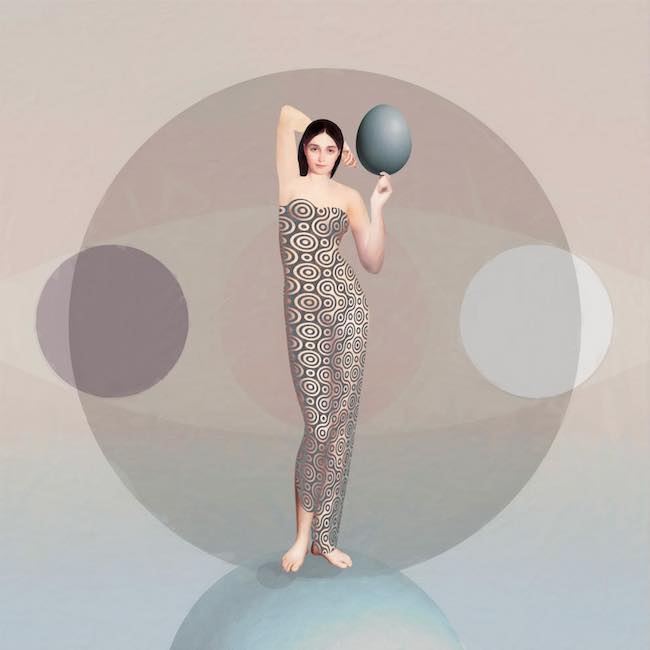
Lo stile di Piero Campanini è incredibilmente contemporaneo sia per l’utilizzo della tecnica digitale, che viene adattata alla sua sensibilità e al suo approccio metafisico alla realtà osservata o ai concetti che desidera far emergere, sia per la sua capacità di lasciar emergere le debolezze e le fragilità dell’individuo moderno anche contrapponendolo alla più solida struttura del passato. Ma soprattutto il suo sguardo è inclusivo, empatico, ammirato nei confronti della donna della quale riesce a mettere in luce la delicatezza, utilizzando una gamma cromatica che tende verso le tonalità pastello proprio per sottolineare la morbidezza di un’essenza che però sa tirare fuori tutta la resilienza e l’attitudine a perseguire in maniera costante i propri obiettivi.
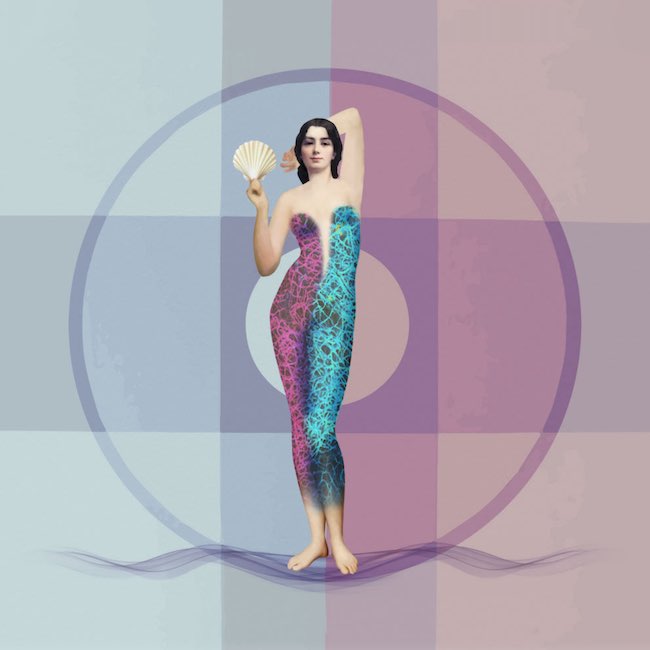
Nell’opera Saffo, Campanini pone al centro della composizione la figura immaginaria della grande poetessa che non solo lasciò ai posteri i più intensi versi dedicati all’amore, ma fu anche una dichiarata rappresentante di un’omosessualità che nella Grecia antica non era considerata peccaminosa come nei secoli successivi; il simbolo metaforico che l’artista pone nella mano della protagonista è la conchiglia, appartenente al mondo delle profondità marine e associata idealmente all’organo genitale femminile. Lo sfondo è essenziale, lo sguardo è coraggioso, quasi volesse sfidare l’intero mondo a non giudicarla bensì semplicemente a lasciarsi andare all’amore in tutte le sue sfaccettature, senza regole, senza barriere.
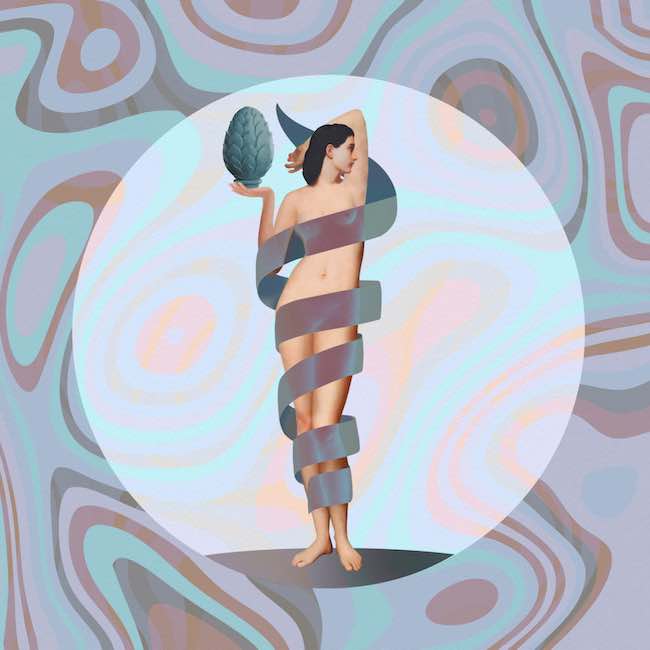
Altra grande protagonista della serie Veneri Millenarie è Rosalind Franklin, la londinese scienziata prima in assoluto a riuscire a fotografare la molecola del DNA e la cui ricerca condusse alla scoperta della struttura a doppia elica che ha stimolato successive esplorazioni e studi sull’essenza fisica dell’essere umano; in questo caso Piero Campanini sceglie come simbolo metaforico la ghianda, associata fin dall’antichità alla possibilità dell’individuo di lasciar crescere da un seme le proprie capacità intellettuali e il proprio talento. La scienziata non poteva non essere avvolta da una stilizzazione della struttura dell’acido della vita e della genetica spiccando da uno sfondo che sembra riprodurre le molecole, i nuclei degli atomi, esattamente tutto ciò che ha contraddistinto il suo percorso professionale, la sua stessa vita.
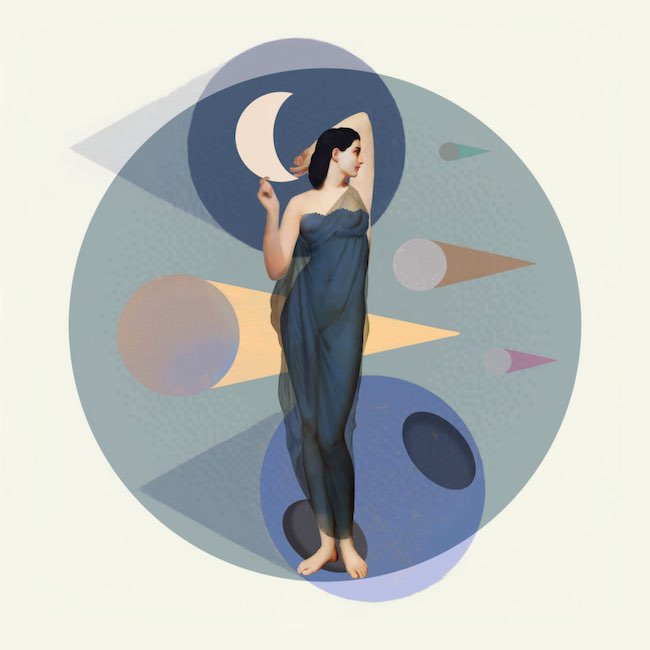
In Valentina Tereškova viene invece messa in luce la forte personalità di una donna coraggiosa oltre ogni limite, capace di sfidare le convenzioni e prepararsi per andare nello spazio, divenendo così la prima cosmonauta di sesso femminile, entrando nella storia ed esplorando l’ignoto che negli anni Sessanta del Novecento costituiva una meta affascinante, misteriosa, una conquista che le grandi potenze del mondo volevano aggiudicarsi. L’elemento distintivo dell’eroina sovietica è la luna, intesa non solo come luogo dell’universo verso cui tendere bensì anche come allegoria di tutto ciò che resta ignoto, il lato del sé da indagare e da osservare nell’intimità dell’introspezione.
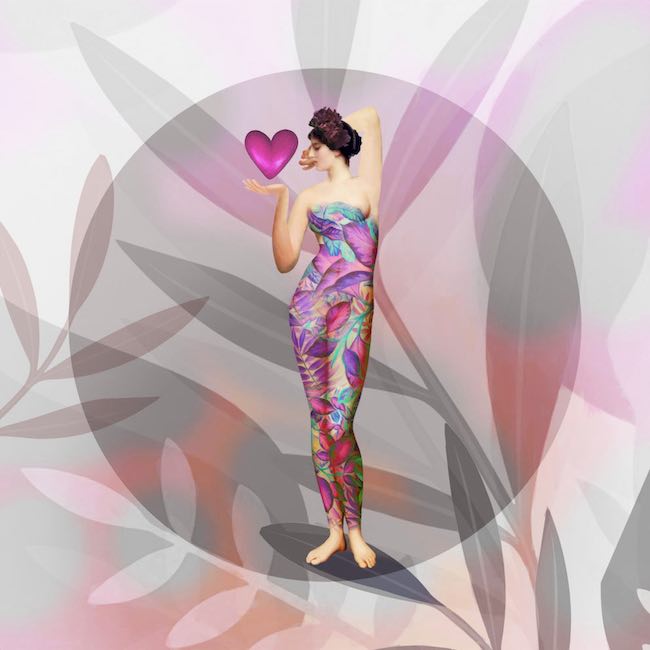
Piero Campanini riporta alla memoria collettiva la rilevanza di queste personalità femminili, ne sottolinea non solo la grazia e l’armonia estetica che sembra essere uniformata e non caratterizzata secondo i canoni delle epoche in cui sono vissute, bensì ne tratteggia la personalità e la sostanza su cui hanno basato l’intera loro esistenza, ciascuna a proprio modo, con un personale approccio e con la modalità nel perseguire gli obiettivi più affine alla propria natura; qualcuna con maggiore impeto, altre con un atteggiamento meno forte ma non meno determinato, tutte le eroine di Campanini hanno costruito la loro fortuna e il loro successo.
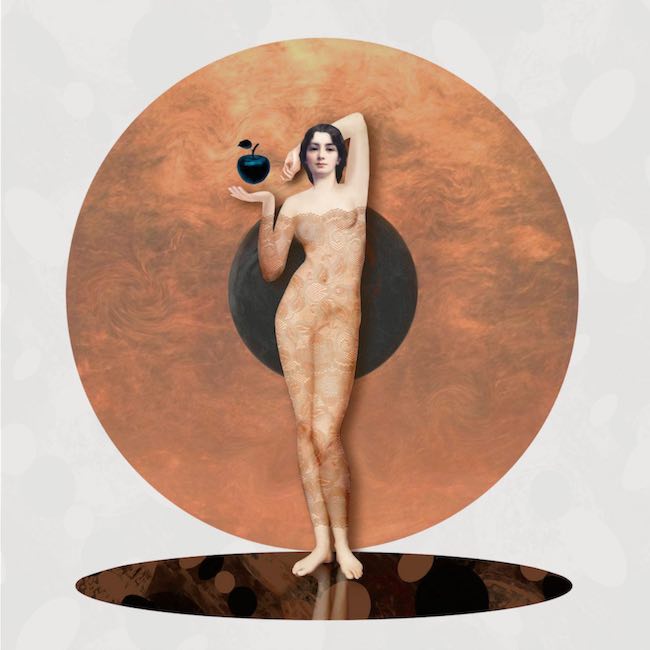
Tra le Veneri non potevano mancare due esponenti del mondo dell’arte: Frida Kahlo più strettamente legata alla pittura, donna resiliente che malgrado il dolore fisico che accompagnò tutta la sua vita così come l’amore tormentato per Diego Rivera da cui non riuscì mai ad allontanarsi, si distinse come una pioniera, esponente del Surrealismo e simbolo di un riconoscimento del valore femminile nell’arte, e Coco Chanel nel campo della moda, creatrice di una linea di abbigliamento controcorrente che stimolava le signore dell’epoca a uscire dagli abiti convenzionali per andare verso una liberazione del corpo dalle linee fascianti ed entrare nel mondo di un’eleganza diversa, più comoda, meno limitante. Entrambe iconiche ed entrambe simbolo di emancipazione, la stessa che dovrebbero continuare a perseguire anche le donne contemporanee, troppo orientate all’apparenza e poco invece alla sostanza. Piero Campanini ha al suo attivo mostre a Milano, Bologna, Como, Calice Ligure e a Madrid; le sue opere sono disponibili anche in multipli certificati. Il progetto Veneri Millenarie sarà in mostra alla Casa del Console di Calice Ligure dall’8 marzo al 16 aprile 2023, in occasione della Giornata Internazionale dei Diritti della Donna.
PIERO CAMPANINI-CONTATTI
Email: contatto@pierocampanini.com
Sito web: www.pierocampanini.com
Facebook: https://www.facebook.com/campaninipiero.art
Instagram: https://www.instagram.com/piero_campanini/
Female emancipation through the celebration of the great women of the past in Piero Campanini’s Digital Art
The woman, as a symbol of harmony and beauty, has always constituted an irresistible fascination for an artistic world predominantly the prerogative of men, at least until the last two centuries; hence the impulse was to immortalise her aesthetics by mixing her with a celestial aura, especially when she was depicted in the form of a divinity, or to discover the mystery concealed behind looks, expressions and poses. Yet despite the mastery of the great names in international painting, the true essence of femininity seemed to escape precisely because of those silences, those hidden thoughts that belonged to the manners and way of life of long ago. The artist I am going to tell you about today recounts, in his own personal style, the path taken by iconic female figures who paved the way for them to break free from their traditional roles and finally enter history, each in their own personal sphere; after which nothing was ever the same again.
Throughout the history of art, there has been no figure more admired, celebrated and portrayed than the woman with all her facets and the aesthetic modifications that have taken place over time based on the tastes, social and aesthetic rules of each period; thus through the artworks of Leonardo da Vinci, Botticelli, Titian, Vermeer, and then again with Giovanni Boldini, Edgar Degas, and Claude Monet, we have a trace of the canons of beauty, dress, and innate grace that these sacred monsters of painting were able to highlight. With the modern period and the coming of the 20th century, the approach to art began to change, as did the way of living and thinking that resulted in the great social protests and revolutions, so the artistic and professional talents of those who could be defined as the pioneers of the later and more incisive emancipation movements aimed at the conquest of rights and possibilities that did not exist before began to emerge; art was a promoter in this sense, as painting was a field considered possible for women, despite the fact that until then only Artemisia Gentileschi, Fede Galizia and a few others had dared to assert themselves in a purely male world.
Thus in Impressionism, the way had already been opened up for Mary Cassat and Berthe Morisot by the courageous and daring female painters of previous centuries, even if the path to achieving the fame of their male colleagues was still a long one. It was the 20th century and the audacity of determined, strong-willed and non-conformist women such as Frida Kahlo, Tamara de Lempicka, Paula Rego, Niki de Sain Phalle and Joan Mitchell that marked the beginning of the consolidation of female art, thus giving a different point of view, more empathetic and revealing of the true essence that could never really be discovered by the interpretation, albeit sometimes infinitely poetic, given by the male masters of the past. But the 20th century constituted a revolution in many aspects, so some women, the most daring and reckleness, had the chance to make their mark in other fields as well, from science to literature via the emerging world of fashion. And it is precisely in this conjunction of great minds, of difficult paths, hindered but fought to achieve the realisation of their professional dream, even becoming an inspiration for the following generations, that Piero Campanini’s latest artistic production entitled Millenary Venuses takes shape. It is a true focus on the female personalities of the past who knew how to write a different story capable of tearing apart and breaking the limits and patterns of the society in which they lived, and becoming an iconic example for entire generations of women to follow. It is not a contemplative approach that of the artist, rather it is a gaze that starts from aesthetics to go deep into the substance, into the most relevant meaning that their story has highlighted, that is, that everything is possible, always and forever, despite the fact that all too often women have not believed, and perhaps still do not believe, in themselves; these true heroines instead have been able to demonstrate how limits only belong to the restrictive convictions of society and the external environment to which we must instead rebel in order to live according to our own rules. Piero Campanini’s style is incredibly contemporary, both for his use of digital technique, which is adapted to his sensitivity and his metaphysical approach to the reality observed or to the concepts he wishes to bring out, and for his ability to allow the weaknesses and fragilities of the modern individual to emerge, even contrasting it with the more solid structure of the past. But above all, his gaze is inclusive, empathetic, admiring towards the woman whose delicacy he manages to highlight, using a chromatic range that tends towards pastel shades precisely to emphasise the softness of an essence that nonetheless knows how to bring out all the resilience and attitude to constantly pursue its goals.
In the artwork Sappho, Campanini places at the centre of the composition the imaginary figure of the great poetess who not only left posterity the most intense verses dedicated to love, but was also an avowed representative of a homosexuality that in ancient Greece was not considered as sinful as it was in later centuries; the metaphorical symbol that the artist places in the hand of the protagonist is the shell, belonging to the world of the deep sea and ideally associated with the female genital organ. The background is essential, the gaze is bold, almost as if she wanted to challenge the whole world not to judge her but simply to let herself go to love in all its facets, without rules, without barriers. Another great protagonist of the Venus Millenarias series is Rosalind Franklin, the London scientist who was the first ever to succeed in photographing the DNA molecule and whose research led to the discovery of the double helix structure that stimulated subsequent explorations and studies on the physical essence of the human being; in this case Piero Campanini chooses as a metaphorical symbol the acorn, associated since antiquity with the individual’s ability to let his intellectual abilities and talent grow from a seed. The scientist could not fail to be enveloped in a stylisation of the structure of the acid of life and genetics, standing out from a background that seems to reproduce the molecules, the nuclei of atoms, exactly everything that has characterised her career, her very life. In Valentina Tereškova, on the other hand, the strong personality of a woman who was courageous beyond all limits, capable of defying conventions and preparing to go into space, thus becoming the first female cosmonaut, entering history and exploring the unknown that in the 1960s constituted a fascinating, mysterious goal, an achievement that the world’s great powers wanted to win.
The distinctive element of the Soviet heroine is the moon, understood not only as a place in the universe towards which to strive but also as an allegory of all that remains unknown, the side of the self to be investigated and observed in the intimacy of introspection. Piero Campanini brings back to the collective memory the relevance of these female personalities, he emphasises not only their grace and aesthetic harmony that seems to be uniform and uncharacterised according to the canons of the eras in which they lived, but also outlines their personalities and the substance on which they based their entire existence, each in their own way, with a personal approach and with the manner in which they pursued their goals most akin to their own nature; some with greater impetus, others with a less strong but no less determined attitude, all of Campanini’s heroines built their fortunes and success. Among the Venuses, two exponents of the art world could not be missing: Frida Kahlo more closely linked to painting, a resilient woman who despite the physical pain that accompanied her entire life as well as her tormented love for Diego Rivera from whom she never managed to distance herself, distinguished herself as a pioneer, an exponent of Surrealism and a symbol of a recognition of female value in art, and Coco Chanel in the field of fashion, the creator of a countercultural fashion line that encouraged the ladies of the time to move away from conventional clothes and towards a liberation of the body from swathing lines and enter the world of a different, more comfortable, less limiting elegance. Both iconic and both symbols of emancipation, the same that contemporary women, too oriented towards appearance and not enough towards substance, should continue to pursue. Piero Campanini has exhibitions in Milan, Bologna, Como, Calice Ligure and Madrid to his credit; his artworks are also available in certified multiples. The Veneri Millenarie project will be on show at the Casa del Console in Calice Ligure from 8 March to 16 April 2023, on the occasion of International Women’s Rights Day.


